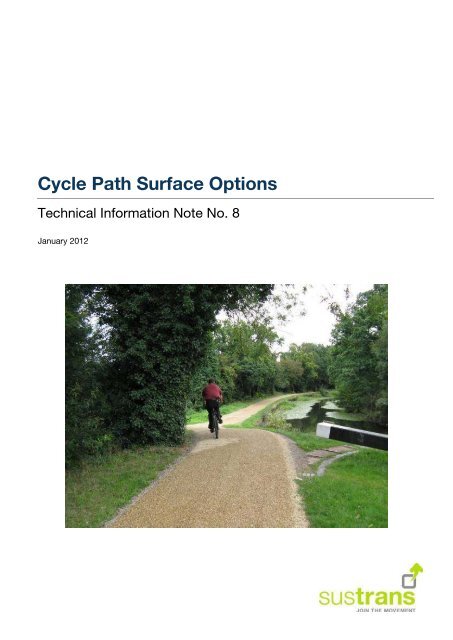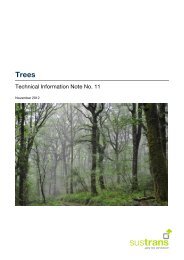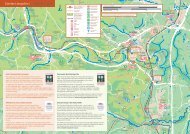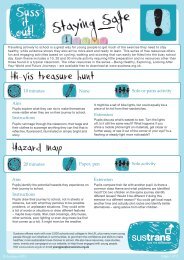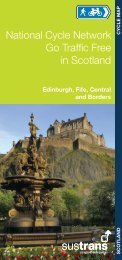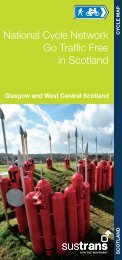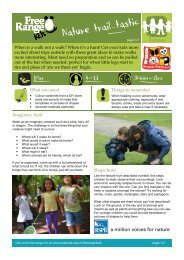TIN08: Cycle Path Surface Options, 2012 - Sustrans
TIN08: Cycle Path Surface Options, 2012 - Sustrans
TIN08: Cycle Path Surface Options, 2012 - Sustrans
Create successful ePaper yourself
Turn your PDF publications into a flip-book with our unique Google optimized e-Paper software.
<strong>Cycle</strong> <strong>Path</strong> <strong>Surface</strong> <strong>Options</strong><br />
Technical Information Note No. 8<br />
January <strong>2012</strong>
About <strong>Sustrans</strong><br />
<strong>Sustrans</strong> makes smarter travel choices possible, desirable and inevitable. We’re a leading UK charity<br />
enabling people to travel by foot, bike or public transport for more of the journeys we make every<br />
day. We work with families, communities, policy-makers and partner organisations so that people<br />
are able to choose healthier, cleaner and cheaper journeys, with better places and spaces to move<br />
through and live in.<br />
It’s time we all began making smarter travel choices. Make your move and support <strong>Sustrans</strong> today.<br />
www.sustrans.org.uk<br />
Head Office<br />
<strong>Sustrans</strong><br />
2 Cathedral Square<br />
College Green<br />
Bristol<br />
BS1 5DD<br />
© <strong>Sustrans</strong> January <strong>2012</strong><br />
Registered Charity No. 326550 (England and Wales) SC039263 (Scotland)<br />
VAT Registration No. 416740656<br />
Issue level: 03<br />
Owned by: NCN Director<br />
Contact: tony.russell@sustrans.org.uk<br />
All photos by <strong>Sustrans</strong> or from the supplier’s web page, unless noted otherwise<br />
1 <strong>Cycle</strong> <strong>Path</strong> <strong>Surface</strong> <strong>Options</strong> Technical Information Note No. 8 January <strong>2012</strong>
Introduction<br />
General requirements for path surface materials for cycle routes would be a smooth riding surface,<br />
good drainage properties, long–term durability, low maintenance, use of sustainable and / or<br />
recycled materials and suitability to sensitive locations.<br />
Not each path material will suit every location – steep hills, waterlogged sites, poor ground<br />
conditions and environmentally sensitive locations each require particularly careful consideration,<br />
and often bespoke designs. Also the presence of utilities below the path may influence the choice of<br />
surface.<br />
<strong>Path</strong> surfaces suitable for cyclists may not be suitable to equestrians – dust paths tend to get<br />
chewed up by horses, and while cyclists normally prefer a smoother surface, horses fare better with<br />
more grip and surface texture. Having a parallel grass path for equestrians might be more useful<br />
rather than finding a surface material suitable to both cyclists and equestrians.<br />
Standard surface options<br />
<strong>Sustrans</strong> default path surface option is a bound surface, either dense bitumen macadam (DBM) or<br />
hot rolled asphalt (HRA). For situations where either of these two surface options is not suitable,<br />
alternative options are outlined later in this document.<br />
Asphalt is a combination of bitumen and aggregate used for road and path construction. It relies for<br />
its strength on the mortar binding together the aggregates (where the mortar is the bitumen + fines +<br />
filler). The aggregate content can vary. Asphalts are more difficult to lay than bitmacs (experienced<br />
contractors must be used), however they offer advantages for simple cycle path construction:<br />
asphalt can be more flexible and therefore tends to deform rather than break should the path base<br />
subside or wash out.<br />
Bitumen–macadam (“bitmac”) is the other combination of bitumen and aggregate used in road and<br />
path construction. It relies for its strength on the stability of the aggregate throughout its grading. As<br />
with asphalt however, the bitumen content can vary and thus bitmacs may have less aggregate than<br />
asphalts. DBM (dense bitumen macadam) is one type of this material.<br />
Standard path cross sections are provided in the Design and Construction section of the <strong>Sustrans</strong><br />
website. Thicknesses of each layer of the path construction need to be adapted to each individual<br />
location.<br />
The bitumen used in making the blacktop can vary slightly in hardness. This is measured in terms of<br />
the bitumen “penetration grade”, which is a measure of how deep a standard needle penetrates the<br />
hardened bitumen at a standard temperature under a standard pressure. Higher penetration grades<br />
(where the needle penetrates deeper) are softer and generate a smoother and more forgiving cycle<br />
path surface. Typical penetration grades for cycle paths are 160/220 pen (softer) or 100/150 pen<br />
(harder). The typical penetration grades for road construction is 100/150 pen. Occasionally harder<br />
penetration grades are used for roads, e.g. for nearside lanes on a motorway (trucks).<br />
The other main variant in blacktop design is the aggregate size that is used. Typically well-graded<br />
aggregate (i.e. a good size distribution down to fine particles) is used. Larger aggregate sizes make a<br />
rougher path surface, which is useful to allow rainwater to trickle through rather than flow across the<br />
surface, but may also allow the accumulation of dust with moss / vegetation growth particularly in<br />
wooded areas. Smaller aggregate gives a smoother riding surface, which is usually preferred by<br />
most cyclists. For HRAs, the percentage aggregate content must be specified when ordering (typical<br />
percentages are 55%, 35% and 30%). Standard maximum aggregate sizes are 20mm, 14mm, 10mm<br />
and 6mm.<br />
2 <strong>Cycle</strong> <strong>Path</strong> <strong>Surface</strong> <strong>Options</strong> Technical Information Note No. 8 January <strong>2012</strong>
Asphalts and bitmacs are produced according to BS EN 13108 “Bituminous mixtures. Material<br />
specifications”. Part 1 of this standard covers DBM, part 4 covers HRA.<br />
This standard also prescribes how to describe a product, as follows:<br />
Type / Aggregate Size / Layer / Penetration grade<br />
The words “surface course” and “binder course” now replace the old terminology of “wearing<br />
course” and “base course”. The term “asphaltic concrete” (AC) is used instead of DBM.<br />
Thus:<br />
AC / 20 / Surf / 100/150 is asphaltic concrete (DBM) with 20mm max aggregate size (down to fines)<br />
for a surface course with 100/150 penetration grade bitumen.<br />
HRA / 30/10 / Surf / 160/220 is hot rolled asphalt (HRA) with 30% aggregate content (10mm max<br />
size) for a surface course with 160/220 penetration grade bitumen.<br />
Alternative surface options<br />
The following table summarises situations where alternatives to the two standard path surface<br />
options (DBM and HRA) mentioned above might need to be considered.<br />
<strong>Path</strong> surface problem<br />
Possible alternative surfaces (in order of<br />
preference)<br />
Appearance / colour of “blacktop” not suitable Coloured bitmac / asphalt<br />
‘Clear’ bitmac / asphalt<br />
Foamed bitumen products<br />
Resin bonded surface treatment<br />
Some self-binding surfaces<br />
Sealing of ground is undesirable (creating<br />
more impermeable surfaces, additional runoff,<br />
etc)<br />
Sustainable sources are desirable /<br />
environmental concerns<br />
No easy access for trucks carrying hot asphalt<br />
/ extended laying time is needed<br />
<strong>Path</strong>side drains (open or closed) – see<br />
standard drawings for details<br />
Porous asphalt<br />
Some self-binding surfaces<br />
Reinforced grass<br />
Blacktop with recycled contents<br />
Foamed bitumen products<br />
Some self-binding surfaces<br />
Vegetable based binders in blacktop<br />
Some self-binding surfaces<br />
Coldlay asphalts / cutback bitumen<br />
asphalts<br />
Foamed bitumen products<br />
Self-binding surfaces<br />
3 <strong>Cycle</strong> <strong>Path</strong> <strong>Surface</strong> <strong>Options</strong> Technical Information Note No. 8 January <strong>2012</strong>
<strong>Path</strong> surface problem<br />
<strong>Surface</strong> too slippery for horses<br />
<strong>Path</strong> close to trees or other reasons that<br />
prevent excavation<br />
Possible alternative surfaces (in order of<br />
preference)<br />
Vegetable based binders in blacktop<br />
Reinforced grass<br />
Forestry paths<br />
Provide parallel grass track<br />
Roll grit into path surface when it is laid<br />
Resin bonded surface treatment<br />
Realign further from trees<br />
No dig construction<br />
These alternatives are described in Appendix A, but should only be considered where the standard<br />
options are not suitable. The Appendix covers:<br />
• Coloured surfaces<br />
• Foamed bitumen products<br />
• Porous asphalt<br />
• Asphalt with recycled content<br />
• Asphalt with vegetable binders<br />
• Coldlay asphalt<br />
• Grit rolled into newly laid surface<br />
• <strong>Surface</strong> dressing: resin bonded / tar spray and chip<br />
• Self-binding surfaces<br />
• Reinforced grass / reinforced sand<br />
• No dig construction<br />
All photos are taken from relevant supplier’s web pages or by <strong>Sustrans</strong>, unless otherwise stated.<br />
Examples are included of suppliers and products but these are not exhaustive and the omission of a<br />
particular product should not be taken to mean that it is any less suitable.<br />
Whilst sealed surfaces are more expensive to construct, their future maintenance costs are<br />
appreciably lower than unsealed surfaces. A comparison of the whole life cost of these two options<br />
is included as Appendix B. Based on a whole life comparison, unbound surfaces are at least 50%<br />
more expensive than bound surfaces. There are many factors that can accelerate the rate of wear on<br />
an unbound path, which would make the cost difference even greater.<br />
Summary<br />
<strong>Sustrans</strong>’ default path surface is machine-laid DBM or HRA, however we recognize that this is not<br />
always possible or desirable, for a variety of reasons. This guide aims to provide an overview of<br />
suitable alternative path surfaces. It is intended to guide negotiation and decision making, however<br />
more detailed guidance must be sought before specifying these materials for construction projects.<br />
4 <strong>Cycle</strong> <strong>Path</strong> <strong>Surface</strong> <strong>Options</strong> Technical Information Note No. 8 January <strong>2012</strong>
Using easily and locally available materials that are easily laid is recommended for all situations. Not<br />
every supplier operates across the whole of the UK and Ireland, and transporting path surface<br />
materials over any distance tends to be very expensive. The same applies to coloured aggregate that<br />
might only be locally available in some regions of the UK.<br />
5 <strong>Cycle</strong> <strong>Path</strong> <strong>Surface</strong> <strong>Options</strong> Technical Information Note No. 8 January <strong>2012</strong>
APPENDIX A: Alternative <strong>Surface</strong> <strong>Options</strong><br />
Coloured surfaces<br />
Description<br />
Benefits<br />
Suitability<br />
Suppliers / brands<br />
Cost<br />
There are two main methods to create coloured bituminous<br />
surfaces:<br />
1. Painting the surface – cheap and easy to apply once the<br />
surface is laid, however the colour tends to peel off over time,<br />
leaving the typical black / grey colour of normal asphalt surfaces.<br />
Once the peeling starts, this becomes unsightly. Slurry seals are<br />
the most common paint used. Any colour is possible. This<br />
method is not recommended.<br />
2. The asphalt / bitmac is prepared using a clear binder and<br />
coloured aggregate. To enhance the finished colour, colour<br />
pigments may be added to the mixture, creating a strongly<br />
coloured finished product. This will fade over time to the colour of<br />
the aggregate used, as bitumen is worn from the riding surface.<br />
Possible colours include red, green, brown, golden, yellowish and<br />
blue tones. Aggregate Industries produces a green fluorescent<br />
aggregate (see picture below). Asphalt made with clear binder<br />
and no pigment will show the natural aggregate colour. This<br />
method lasts longer.<br />
Coloured asphalt has the same ride quality and strength as black<br />
/ grey asphalt<br />
Coloured asphalt is useful for highlighting cycle facilities in urban<br />
areas (typically red or green is used). In rural areas, clear or<br />
coloured asphalt can be used to blend the path surface with its<br />
surroundings (typically brown, red or golden tones)<br />
Most large asphalt suppliers stock clear binders and offer to add<br />
colour pigments as required. Coloured aggregate usually needs to<br />
be transported long distances, typically only one colour is<br />
available from local quarries, depending on local rock types.<br />
Cost varies depending on the availability of coloured aggregate,<br />
and necessary transport. Clear bitumen can be up to double the<br />
cost of black bitumen, however it is only a minor constituent of<br />
the path surface. Typical material cost is 1 ½ - 2 times that of<br />
black/grey asphalt. Laying costs are the same as black asphalt.<br />
6 <strong>Cycle</strong> <strong>Path</strong> <strong>Surface</strong> <strong>Options</strong> Technical Information Note No. 8 January <strong>2012</strong>
Coloured surfaces<br />
Fluorescent aggregate<br />
Coloured asphalt samples<br />
7 <strong>Cycle</strong> <strong>Path</strong> <strong>Surface</strong> <strong>Options</strong> Technical Information Note No. 8 January <strong>2012</strong>
Foamed bitumen products<br />
Description<br />
Foamed bitumen has been developed as a method of<br />
recycling road planings to become a new path surface.<br />
Bitumen is foamed to increase its volume, and to more<br />
effectively coat aggregate materials. It is then mixed with<br />
carefully screened road planings. The bitumen already<br />
present in the road planings adds to the strength of the<br />
finished product.<br />
Foamed bitumen surfaces can be laid cold or hot. Cement or<br />
pulverized fuel ash is sometimes added to increase the<br />
strength of the surface.<br />
The surface needs to be machine laid and rolled and<br />
compacted properly to bond.<br />
Benefits<br />
Suitability<br />
Suppliers / brands<br />
Cost<br />
When designed to be laid cold, this material can be stored<br />
on site for up to several weeks<br />
This material has a high recycling content. Portable mixing<br />
plants are available.<br />
Material with added cement has a grey (cementious) colour<br />
rather than bituminous black<br />
Suitable where road planings and foaming plant is available<br />
locally.<br />
This material is very durable.<br />
Roadstone Recycling produces “Foamix”<br />
Ringway produces “Foambase”<br />
Tarmac produces “FoamMaster”<br />
Less or similar to “normal” DBM, depending on the<br />
availability of road planings<br />
8 <strong>Cycle</strong> <strong>Path</strong> <strong>Surface</strong> <strong>Options</strong> Technical Information Note No. 8 January <strong>2012</strong>
Foamed bitumen products<br />
Foamed bitumen path with added cement.<br />
9 <strong>Cycle</strong> <strong>Path</strong> <strong>Surface</strong> <strong>Options</strong> Technical Information Note No. 8 January <strong>2012</strong>
Porous asphalt<br />
Description<br />
Benefits<br />
Suitability<br />
Suppliers / brands<br />
Cost<br />
Asphalt can be made porous by eliminating finer<br />
particles from the aggregate mix. This way voids<br />
are created in the asphalt where water can seep<br />
through.<br />
The underlying path base will need to be made<br />
porous as well to allow better drainage, by also<br />
eliminating fine particles. This makes the base more<br />
difficult to compact properly, and the paver might<br />
create ruts while running over the base.<br />
Rainwater can seep through the path surface and<br />
so pathside drainage provision can be reduced.<br />
This is particularly beneficial in dense urban<br />
environments, or where drainage would otherwise<br />
be difficult.<br />
Porous asphalt should not be relied upon in the<br />
long term, as the water pathways tend to clog with<br />
dust particles and mud, particularly in low trafficked<br />
or wooded areas, allowing moss / vegetation<br />
growth. High-pressure water jetting cleans the<br />
pores somewhat, but never returns to the original<br />
state.<br />
Porous asphalt has a rougher surface than normal<br />
asphalt.<br />
Any supplier can create porous asphalt.<br />
Similar to normal asphalt.<br />
Porous asphalt at back, normal asphalt at front (picture from supplier)<br />
10 <strong>Cycle</strong> <strong>Path</strong> <strong>Surface</strong> <strong>Options</strong> Technical Information Note No. 8 January <strong>2012</strong>
Porous asphalt<br />
Open pores (fresh porous asphalt)<br />
Clogged pores due to dust and mud<br />
11 <strong>Cycle</strong> <strong>Path</strong> <strong>Surface</strong> <strong>Options</strong> Technical Information Note No. 8 January <strong>2012</strong>
Asphalts with recycled content<br />
Description<br />
Benefits<br />
Suitability<br />
Suppliers /<br />
brands<br />
Cost<br />
When mixing asphalt there is no real difference in material quality<br />
between asphalt made with freshly quarried or asphalt made with<br />
recycled aggregates. There are several options:<br />
Replace part of the aggregate with road planings. This can be done<br />
provided the asphalt supplier adjusts the bitumen content accordingly,<br />
and tar-based planings are avoided (they are carcinogenic).<br />
Replace quarried aggregate with recycled aggregate – see Technical<br />
Information Note 7 on aggregate. Provided aggregate meets the same<br />
quality standard, there is no problem.<br />
There are many other ideas of mixing recycled or waste products into<br />
asphalt. It is advisable to test each one on their individual merit. Using<br />
tyre rubber for cycle paths is not recommended, as the rubber does not<br />
bond well with the bitumen.<br />
Where recycled products are locally available using these materials can<br />
save on transport (cost) and reduces quarrying.<br />
The finished surface looks and feels the same as asphalt mixed with<br />
non-recycled contents.<br />
Unless porous asphalt is used, leaching is not normally a problem.<br />
Most asphalt suppliers now have products with recycled contents<br />
available.<br />
Same or similar than the non-recycled product it replaces<br />
12 <strong>Cycle</strong> <strong>Path</strong> <strong>Surface</strong> <strong>Options</strong> Technical Information Note No. 8 January <strong>2012</strong>
Asphalt with vegetable binders<br />
Description<br />
Benefits<br />
Suitability<br />
Suppliers /<br />
brands<br />
Cost<br />
This is asphalt where the bitumen is replaced by a vegetable-based<br />
binder. It is laid as conventional asphalt, however the laying<br />
temperature tends to be lower.<br />
The oil-based bitumen is avoided, and replaced with a (renewable)<br />
plant-based binder.<br />
Strength and surface smoothness are the same as with bitumen-based<br />
asphalts.<br />
The binder is colourless, therefore colour pigments can be added to<br />
create any path colour that is wanted, and the aggregate colour will<br />
show.<br />
Suitable as replacement for any other bound surface.<br />
Colas produces and exclusively lays “Vegecol”<br />
Shell produces “Floraphalte”<br />
Comparable to coloured bituminous surfaces<br />
Vegecol at Basingstoke Canal, Woking<br />
Vegecol at Basingstoke Canal, Woking<br />
13 <strong>Cycle</strong> <strong>Path</strong> <strong>Surface</strong> <strong>Options</strong> Technical Information Note No. 8 January <strong>2012</strong>
Coldlay asphalt<br />
Description<br />
Benefits<br />
Suitability<br />
Suppliers /<br />
brands<br />
Cost<br />
Coldlay products are designed asphalts for difficult situations, in<br />
particular where it is necessary to deal with long delivery routes or<br />
where the asphalt needs to be stored on site before laying. Oils are<br />
added to the bitumen when the asphalt is batched (called “cutback<br />
bitumen”), with the effect that the asphalt remains workable at lower or<br />
ambient temperatures. Within days the oil evaporates from the finished<br />
surface, so that the asphalt hardens at ambient temperatures.<br />
The asphalt can be stored on site for hours or even days, allowing<br />
slower construction methods. Larger quantities of asphalt can be<br />
delivered to site, rather than calling off small volumes when a section of<br />
path is ready.<br />
The oils in the cutback bitumen should evaporate over time, so that the<br />
finished product is the same as ‘normal’ blacktop. This never works<br />
100%, meaning that the asphalt is softer.<br />
Use of the path (especially to heavy vehicles and horses) must be<br />
limited until the path has initially hardened.<br />
The finished surface looks and feels the same as hot asphalt<br />
Most asphalt suppliers have coldlay / cutback products available. One<br />
example is “pathmaster” (by Tarmac), but choose what is available<br />
closest to you.<br />
Comparable to hot asphalt. Transport costs may be less if deliveries to<br />
site can be optimised.<br />
14 <strong>Cycle</strong> <strong>Path</strong> <strong>Surface</strong> <strong>Options</strong> Technical Information Note No. 8 January <strong>2012</strong>
Grit rolled into newly laid surface<br />
Description<br />
Benefits<br />
Suitability<br />
Suppliers /<br />
brands<br />
Cost<br />
After initially laying a bituminous surface approx 1kg / m2 of 3mm grit is<br />
sprinkled on the path surface and rolled in using motorised rollers.<br />
Excess grit to be swept from path surface and reused at further<br />
sections of path.<br />
Can be very effective method to slightly alter colour of surface (if<br />
coloured grit is used).<br />
If not swept properly after application, this surface can be dangerous.<br />
This method is particularly useful for generating surface grip that is<br />
useful for horses<br />
Surplus grit must be swept from the path surface before the path is<br />
opened for use by cyclists, walkers and equestrians.<br />
Any aggregate supplier can provide grit<br />
Depending on colour and quantity used. Less than resin-bonded<br />
surface treatment.<br />
Gritted path surface<br />
Detail of gritted surface, wth some loose stones<br />
15 <strong>Cycle</strong> <strong>Path</strong> <strong>Surface</strong> <strong>Options</strong> Technical Information Note No. 8 January <strong>2012</strong>
<strong>Surface</strong> dressing: resin bonded / tar spray and chip<br />
Description<br />
Benefits<br />
Suitability<br />
Suppliers /<br />
brands<br />
This treatment is applied to an existing bound surface, and comprises<br />
a thin layer of chippings applied to a surface dressing adhesive. It can<br />
also be directly applied to a stone base.<br />
It works by gluing small aggregate particles onto an already existing or<br />
newly laid asphalt surface or stone base using a resin or a hot sprayed<br />
coat of bitumen emulsion, and thus provides the appearance of loose<br />
gravel (in the colour of the gravel). The aggregate however is not loose<br />
but firmly held in place, and adds grip. This surface treatment is<br />
increasingly seen on roads, including on the approach to traffic lights<br />
or roundabouts, where increased skid resistance is wanted. Similarly it<br />
improves the grip for horses.<br />
This can be used to change the colour or grip of an existing (grey)<br />
asphalt path. The finished look of the resin bonded surface treatment<br />
will depend on the colour of the aggregate used (typically yellows,<br />
browns or light greys).<br />
This method only works on surfaces that are smooth and even, as the<br />
finished surface treatment has only minimal thickness; it can be laid on<br />
any sound constructed surface in good condition, however, concrete,<br />
steel and timber will require additional preparation.<br />
Loose aggregate must be swept from the finished path before opening<br />
it to cycle traffic. We have had some problems due to the chippings<br />
being laid too thickly in the first place, which should be avoided.<br />
If the surface treatment is applied directly to a stone base, then two<br />
layers of the surface treatment are required (lower layer 6mm stone,<br />
upper layer 3 – 6mm stone). This type of surface has been frequently<br />
used in the early days of the NCN.<br />
Where an unbound surfacing has been specified, localised use of a<br />
resin boded material is recommended on particularly vulnerable<br />
sections such as:<br />
• where erosion is likely to take place such as on steep slopes,<br />
sharp corners, junctions or under bridges,<br />
• with difficult drainage or where water is present,<br />
• where heavy traffic uses a path<br />
• where equestrians use a path.<br />
<strong>Surface</strong> dressing may also be used to increase skid resistance on a<br />
gradient or round a bend.<br />
Available form most contractors or aggregate / asphalt suppliers<br />
There is a wide variety of products available so best to check with the<br />
contractor / supplier what products are recommended to address the<br />
specifics of the site. As products vary in nature and application it can<br />
be worth using a product the contactor is familiar with so they are<br />
practiced in the correct techniques.<br />
The specific product is usually the resin and a variety of stone can be<br />
16 <strong>Cycle</strong> <strong>Path</strong> <strong>Surface</strong> <strong>Options</strong> Technical Information Note No. 8 January <strong>2012</strong>
<strong>Surface</strong> dressing: resin bonded / tar spray and chip<br />
used to suit the environment / local availability. For example British<br />
Waterways in Scotland use Ayton Products – Aquagrip because their<br />
contractor is fully trained in the application of the resin. It is used<br />
along with a 6mm Whin stone chip to conform to Historic Scotland<br />
Requirements<br />
Product such as Prismo Textureflex are used to highlight areas it<br />
increase skid resistance and have chip of up to 3mm. These have<br />
excellent skid resistance and a range of colours; they tend to be<br />
applied as a slurry with the chips already mixed.<br />
Resins can be very susceptible to failure if they are laid in the incorrect<br />
conditions, usually when it is cold or wet. Always check with the<br />
supplier and ensure the contractor works with in the specified<br />
temperature and moisture ranges.<br />
Fibredec is a specific surface treatment combining bitumen emulsion,<br />
chopped glass fibres and aggregate, produced by Colas. <strong>Sustrans</strong><br />
staff should liaise with the technical department if they are considering<br />
using this product.<br />
Cost<br />
<strong>Surface</strong> dressing may cost between £15 - £35 / m2 (material & labour)<br />
in addition to the construction cost of the original asphalt surface,<br />
depending on aggregate and supplier used.<br />
Rhyl Promenade (Roy Spilsbury, CTC)<br />
17 <strong>Cycle</strong> <strong>Path</strong> <strong>Surface</strong> <strong>Options</strong> Technical Information Note No. 8 January <strong>2012</strong>
Self-binding surfaces<br />
Description<br />
Benefits<br />
Suitability<br />
Selection of<br />
suppliers /<br />
brands (not<br />
exhaustive)<br />
Self-binding gravel paths are versions of the standard limestone dust<br />
surface. All options require a 100 – 150mm thick aggregate base. There<br />
are many different products available, and most are only marketed<br />
regionally – contractors and builder’s merchants should have local<br />
information available. Self-binding materials may be based on<br />
limestone, slate waste or granite waste and others.<br />
The material is spread and levelled using a paving machine whilst<br />
damp/moist and then compacted using a roller or vibrating plate. The<br />
material 'sets' when dry, but not to the same extent as would a<br />
concrete or bitmac. The surface remains loose-ish and dusty, but does<br />
'harden' to the point of becoming impermeable in some heavily<br />
trafficked projects. Each material is different and therefore it is<br />
important to visit a site where the desired material has been laid several<br />
years ago to see how it performs.<br />
This range of products is suitable for lightly trafficked environmentally<br />
sensitive areas. It does not harden quickly after delivery, therefore<br />
allowing time to get the material into difficult work sites (it can be<br />
stockpiled for a few days on site before laying).<br />
Suitable as alternatives to limestone dust surfaces, and where a bound<br />
surface is not acceptable.<br />
Self-binding surfaces tend not to work very well in areas<br />
• where erosion is likely to take place such as on steep slopes,<br />
sharp corners, junctions or under bridges,<br />
• with difficult drainage or where water is present,<br />
• where heavy traffic uses a path<br />
• where equestrians use a path.<br />
Where this type of surface is chosen, localised use of resin bonded or<br />
other sealed surfaces is recommended for such vulnerable sections.<br />
The life-cycle of self-binding surfaces tends to be significantly shorter<br />
than for bound surfaces (see Appendix B), and there is a continuous<br />
problem with overgrowing vegetation, ponding and pothole<br />
development, which very quickly make paths unacceptable to many<br />
cyclists and walkers (unless repaired quickly). Self-binding path<br />
surfaces can be easily repaired.<br />
The quality of the surface is sensitive to the workmanship with which it<br />
is laid so effort must be put into ensuring a high level of quality control,<br />
and it is important to select a contractor with sound experience of the<br />
particular product to be used.<br />
Breedon Gravel (supplied by Breedon Aggregates) – the material laid<br />
across Queen Square in Bristol (on route between Temple Meads and<br />
<strong>Sustrans</strong> head office). Golden / amber colour<br />
Cedec (supplied by Ced Ltd) – can be grey, gold or reddish. Should not<br />
18 <strong>Cycle</strong> <strong>Path</strong> <strong>Surface</strong> <strong>Options</strong> Technical Information Note No. 8 January <strong>2012</strong>
Self-binding surfaces<br />
be laid too deeply.<br />
Centrac (supplied by Central Construction Services Ltd) – buff colour<br />
Coxwell Gravel - slightly reddish colour. It has been used on various<br />
sections of the NCN and is best suited to paths that are level and lightly<br />
used.<br />
Finepath (supplied by Tarmac) is made of recycled blast furnace slag,<br />
steel slag and secondary dusts, with added colour pigments. There<br />
have been frost-heave problems when laid in cold weather, otherwise<br />
the material is very frost resistant. This material has been used by<br />
British Waterways in the West Midlands (NCN 54)<br />
Goldpath (supplied by builder’s merchants) – golden / amber colour.<br />
Hoggin – composed of a well graded mixture of gravel, sand and clay,<br />
producing a buff colourer surface.<br />
Toptrec (supplied by Tarmac) - 100% recycled pathway material. It has<br />
in the past been used on NCN 5 in Kidsgrove (Staffs), but has now been<br />
overlaid with a bituminous surface. Used on NCN 767 in<br />
Clackmannanshire as a demonstration of different surfaces.<br />
Cost<br />
Varies from product to product, but generally slightly cheaper to install<br />
than bituminous surfaces. Whole-life costs are generally more<br />
expensive than for bituminous surfaces (see Appendix B)<br />
Toptrec (NCN 5 in Staffordshire)<br />
Breedon Gravel<br />
19 <strong>Cycle</strong> <strong>Path</strong> <strong>Surface</strong> <strong>Options</strong> Technical Information Note No. 8 January <strong>2012</strong>
Self-binding surfaces<br />
Finepath in Birmingham<br />
Finepath (NCN 54 in Wolverhampton)<br />
Coxwell Gravel (NCN 6, Dunstable)<br />
Coxwell Gravel<br />
Goldpath<br />
Goldpath<br />
Hoggin<br />
20 <strong>Cycle</strong> <strong>Path</strong> <strong>Surface</strong> <strong>Options</strong> Technical Information Note No. 8 January <strong>2012</strong>
Reinforced grass / reinforced sand<br />
Description<br />
Benefits<br />
Suitability<br />
Suppliers / brands<br />
Cost<br />
Interlocking plastic grids laid on top of a type 1 (or similar) base. The<br />
plastic grids are typically around 1 foot square in size, and are connected<br />
to each other like puzzle pieces. The grid sections are then filled with soil<br />
/ sand / gravel, and can be seeded if necessary.<br />
Useful for paths along beaches or dunes, or where a grass surface must<br />
be maintained. Reinforcing sand or grass allows developing cycle or<br />
walking routes where any imported surfacing material would not<br />
otherwise be permitted.<br />
Reinforced grass / sand / gravel surfaces are permeable. The path adapts<br />
very well to ground undulations.<br />
The finished surface allows trafficking by light vehicles.<br />
This surface can work in areas that are prone to flooding.<br />
Suitable for short sections of path where the path needs to blend in<br />
completely with nature. Needs regular maintenance (to cut grass or to<br />
combat sand / soil erosion), otherwise the path can quickly become<br />
buried in sand or overgrown by grass. The surface is not perfectly smooth<br />
to cycle over.<br />
Heavy or turning vehicles can cause damage, as can livestock hooves.<br />
Some products are made from 100% recycled plastic.<br />
“Netpave” has been successfully used by <strong>Sustrans</strong> for some paths along<br />
beaches. Other suppliers are also available. Not all products are well<br />
suited to forming bends in the path alignment.<br />
Approx £20 / m2 on NCN 7 southwest of Glasgow (material and labour)<br />
21 <strong>Cycle</strong> <strong>Path</strong> <strong>Surface</strong> <strong>Options</strong> Technical Information Note No. 8 January <strong>2012</strong>
Reinforced grass / reinforced sand<br />
NCN 7 in Lochwinnoch<br />
Grass surface in Leighton Linslade<br />
22 <strong>Cycle</strong> <strong>Path</strong> <strong>Surface</strong> <strong>Options</strong> Technical Information Note No. 8 January <strong>2012</strong>
‘No dig’ construction<br />
Description<br />
Benefits<br />
Suitability<br />
Suppliers /<br />
brands<br />
Cost<br />
In locations where ground conditions prevent excavation for the<br />
sub base, such as over tree roots, the path may need to be<br />
constructed on the existing ground surface. Interlocking plastic<br />
grids are laid on top of the existing ground and are filled with Type<br />
1 sub base; the path is then finished with a base course and<br />
porous wearing course.<br />
In recognition of the fact that trees are sensitive to disturbance,<br />
normal construction methods should not be used within the root<br />
protection area.<br />
Above ground, no dig, construction avoids tree root severance or<br />
soil compaction, which can be seriously detrimental to tree health.<br />
The three dimensional cellular confinement system distributes the<br />
vertical load on the sub soil and protects tree roots. Only surface<br />
vegetation need be removed.<br />
The finished surface allows trafficking by light vehicles.<br />
These cellular retention systems can be also built up over several<br />
layers to construct steep embankment slopes<br />
<strong>Path</strong>s over tree roots should maintain a porous surface, such as<br />
reinforced grass, porous asphalt, gravel or block paviors.<br />
CellWeb marketed by Geosynthetics Ltd has been used on the<br />
Cheshunt Connect2 scheme<br />
Terram Geocell System is an alternative no dig system.<br />
To follow<br />
Terram Geocells<br />
CellWeb<br />
23 <strong>Cycle</strong> <strong>Path</strong> <strong>Surface</strong> <strong>Options</strong> Technical Information Note No. 8 January <strong>2012</strong>
APPENDIX B: Whole Life Costs Comparison for <strong>Path</strong>s<br />
<strong>Sustrans</strong> initially surfaced many off-road sections of the National <strong>Cycle</strong> Network with unbound<br />
limestone or granite dust surfaces, which were considered most economic and more environmentally<br />
friendly at the time. Experience over the last 15-<br />
20 years or so has shown however that already<br />
significant path sections have suffered erosion,<br />
rutting, ponding or other damage that make<br />
these paths very unattractive and unusable in<br />
very wet weather conditions. Annual<br />
maintenance requirements for unbound<br />
surfaces are generally higher than for bound<br />
surfaces.<br />
This Appendix provides an example of how the<br />
whole life costs of a path, including<br />
construction, routine maintenance and major<br />
repairs, varies between different surface types.<br />
Rural <strong>Path</strong>s<br />
<strong>Path</strong> construction for bound surface: £30/m² without ancillaries. <strong>Path</strong> surface lasts 25–30 years, then<br />
major repairs and additional wearing course required (approx £15/m²). Annual maintenance cost £1-<br />
2/m²/year. Therefore total cost for 50 year life-cycle per m² of path construction (at current cost):<br />
• Initial construction £30<br />
• Repair after 25 yrs £15<br />
• Annual maintenance (50 x £1.50) £75<br />
• TOTAL £120/m²<br />
Comparable construction with limestone dust - £25/m² without ancillaries. <strong>Path</strong> surface lasts 12<br />
years, then requires thorough repair / resurfacing (approx £15/m²). Annual maintenance costs are<br />
higher than for bound surfaces, around £2/m²/year. Therefore total cost for 50 year life-cycle per m²<br />
of path construction (at current cost):<br />
• Initial construction £25<br />
• Repairs after 12, 25 & 37yrs £45<br />
• Annual maintenance (50 x £2) £100<br />
• TOTAL £170/m²<br />
This total could increase considerably if the path wears at a faster rate, possibly needing a complete<br />
rebuild after a shorter period. This may be due, for example, to an exposed position, heavy usage,<br />
inadequate drainage, under bridges, at junctions, on gradients or use by horses.<br />
24 <strong>Cycle</strong> <strong>Path</strong> <strong>Surface</strong> <strong>Options</strong> Technical Information Note No. 8 January <strong>2012</strong>
Urban Fringe and Urban <strong>Path</strong>s<br />
Similar comparisons could be demonstrated for urban fringe and urban routes. Where paths are<br />
more heavily used, unbound surfaces require proportionally more repair and maintenance than in the<br />
above example.<br />
Conclusions<br />
Bulk material consumption for the initial path construction is similar for unbound and bound<br />
surfaces; however over a 50 year life-cycle unbound surfaces will require more additional aggregate<br />
for repair than bound surfaces.<br />
Based on a whole life comparison, unbound surfaces are at least 50% more expensive than bound<br />
surfaces. However, there are many factors that can accelerate the rate of wear on an unbound path,<br />
which would make the cost difference even greater.<br />
25 <strong>Cycle</strong> <strong>Path</strong> <strong>Surface</strong> <strong>Options</strong> Technical Information Note No. 8 January <strong>2012</strong>


